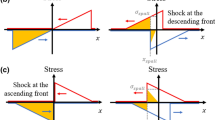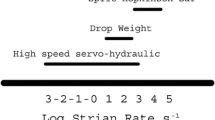Abstract
This paper presents a device that has been designed for tensile loading at medium impact rates (up to 103 s–1) and for performing either interrupted or failure tests. This machine allows us to apply prescribed pre-straining to the specimen, and then apply subsequent loading histories such as impact fatigue. Two specimen loading systems are considered, which make it possible to carry out tests with various ranges of force and various durations of time. A multi-CCD camera system is triggered by a chosen threshold from the force signal. The system is dedicated to the displacement measurement and gives both qualitative and quantitative information about the stretching mechanism leading to fracture. To illustrate the performance of the device, experimental results concerning impact tensile tests at a strain rate of about 300 s–1 are presented, as well as consecutive impact-fatigue tests on two aluminium alloys.
Similar content being viewed by others
References
Auzanneau T, Froustey C, Lataillade JL (2001) Acceptable prior fatigue damage threshold for impact loading of an aluminium alloy. Fatigue Fract Eng Mater Struct 24(n1):23–32.
Cole BN, Sturges JL (2003) The flying wedge: a method for high-strain-rate tensile testing. Part 2. Characteristics of the device. Int J Impact Eng 28:891–908.
Field JE, Walley SM, Proud WG, Goldrein HT, Siviour CR (2004) Review of experimental techniques for high rate deformation and shock stuies. Int J Impact Eng 30:725–775.
Gros V (1996) Etude de l’amorcage et de la propagation des fissures de fatigue dans les essieux-axes ferroviaires. PhD thesis, École Centrale de Paris (in French).
Hopperstad OS, Borvik T, Langseth M, Labibes K, Albertini C (2003) On the influence of stress triaxiality and strain rate on the behaviour of a structural steel. Part I. Experiments. Eur J Mech A Solids 22:1–13.
Itabashi M, Fukuda H (2000) High velocity tensile behavior and some micro-observations for pre-fatigued 2219-T87 and 6061-T6 aluminium alloys. International conference on Processing and manufacturing of advanced material. Thermec, December.
Itabashi M, Kawata K, Kusaka S (1996) Mechanical characterisation of prefatigued 2219-T87 and 6061-T6 aluminium alloys under high velocity tension. Structural Failure:Technical, Legal and Insurance Aspects, pp 151–176.
Kawata K, Itabashi M, Kusaka S (1996) Behaviour analysis of prefatigue damage aluminium alloys under high-velocity and quasi-static tension. IUTAM Symposium on Micromechanics of Plasticity and Damage of Multiphase Materials, pp 397–404.
Lataillade JL, Bacon C, Collombet F, Delaet M (1994) The benefit of Hopkinson bar techniques for the investigation of composite and ceramic materials. Symposium on Wave Propagation and Emerging Technologies, Chicago, US, November.
Lataillade JL (2007) Dynamic Tests. In : Structural Components. Mechanical Tests and Behavioral Laws. Hermes Science and Lavoisier Company, Edited by Dominique Francois, Fr, 2007. ISBN:1905209185.
Martinez CM, Eylon D, Nicholas T, Thompson SR, Ruschau JJ, Birkbeck J, Porter WJ (2002) Effects of ballistic impact damage on fatigue crack initiation in Ti-6Al-4V simulated engine blades. Mater Sci Eng A325:465–477.
Meyers MA (1994) Dynamic behaviour of materials. Wiley, New York. ISBN:0-471-58262-X.
Peterson RE (1974) Stress concentration factors. Wiley, New York. ISBN:0-471-68329-9.
Peters JO, Ritchie RO (2000) Influence of foreign object damage on crack initiation and early crack growth during high-cycle fatigue of Ti-6Al-4V. Eng Fracture Mech 67:193–207.
Quinlan MF, Hillery MT (2004) High-strain-rate testing of beryllium copper at elevated temperatures. J Mater Process Technol 153–154:1051–1057.
Sturges JL, Cole BN (2001) The flying wedge : a method for high-strain-rate tensile testing. Part 1. Reasons for its development and general description. Int J Impact Eng 25:251–264.
Verleysen P, Vanduynslager P, Van Slycken J, Vermeulen M, Degrieck J (2006) High strain rate properties of fatigued advanced high strength steel sheets. J Phys IV 134: 1307–1312.
Author information
Authors and Affiliations
Corresponding author
Rights and permissions
About this article
Cite this article
Froustey, C., Lambert, M., Charles, J.L. et al. Design of an Impact Loading Machine Based on a Flywheel Device: Application to the Fatigue Resistance of the High Rate Pre-straining Sensitivity of Aluminium Alloys. Exp Mech 47, 709–721 (2007). https://doi.org/10.1007/s11340-007-9082-4
Received:
Accepted:
Published:
Issue Date:
DOI: https://doi.org/10.1007/s11340-007-9082-4




